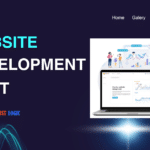
Website Design Checklist for Small Businesses
Build a Strong Digital Foundation for Your Company

1. Design – Planning and Strategy
Identify the Goal of the Website
The first step in building any website is to define its primary objective.
Is your website meant to sell products, share services, or build a brand presence?
A website is more than just a company introduction — it is a powerful marketing tool. Clearly defining the purpose will shape every decision you make during the design process.
Market and Competitor Research
Before designing your website, study your competitors:
– What kind of templates do they use?
– How do they structure their homepage, service pages, and client testimonials?
– What features help them stand out?
Competitor analysis helps you avoid mistakes and adopt best practices.
Understanding Industry Trends
Website design should not look outdated. Your design should feel fresh and modern, meeting the expectations of your target audience.
Stay updated with current trends like:
– Clean, minimalist layout
– Mobile responsiveness
– Interactive elements
– Dark/light mode options
Analyze Market Gaps and Opportunities
Every industry goes through changes. Find out:
– What’s missing in your market?
– How can your website fill that gap?
Use branding and user-friendly navigation to stand out and retain users.
Plan the Layout of Your Website
Use web design tools like WordPress, Wix, or Webflow to browse templates. Select one that suits your brand vision. Plan with your team to include must-have pages:
– Home
– About Us
– Products/Services
– Client List with Logos
– Contact Page
– Testimonials or Reviews
– Blog
Ensure each page is informative, visually attractive, and consistent with your brand. Use high-quality images.
2. Branding
Make Your Homepage a Reflection of Your Brand
Your homepage should immediately convey:
– What your company does
– Why people should trust you
– Visual appeal and professionalism
Include company tagline, featured services, client reviews, and a strong call-to-action (CTA).
Logo, Typography, and Colors
Your logo is the face of your business. Even with a small budget, create a clean and memorable logo. Use tools like Canva, Look , or Free Logo Design.
Keep typography simple and readable with web-safe fonts like Roboto, Open Sans, or Lato. Avoid using more than 2–3 colors for a clean, professional look.
3. Technical Setup
Select a Domain Name
Your domain is your online identity. Tips:
– Keep it short, simple, and memorable
– Match it with your brand name
– Prefer extensions like .com or .in
Once finalized, register it immediately.
Choose a Web Hosting Provider
Hosting impacts your website’s speed, uptime, and scalability. Choose based on your budget:
– Shared Hosting: For small websites, low traffic, cheapest option.
– VPS Hosting: Medium businesses, better performance.
– Cloud Hosting: Scalable, high uptime.
– Dedicated Hosting: For high-traffic sites, most control, costly.
Install an SSL Certificate
SSL is essential. It:
– Encrypts data
– Adds ‘https://’ and a padlock icon
– Protects against threats
– Improves SEO and user trust
Never launch a site without SSL.
Final Words
A small business with a well-planned and beautifully designed website can compete with industry leaders. Your website is the digital face of your business — it creates the first impression. Design smart, think long-term










